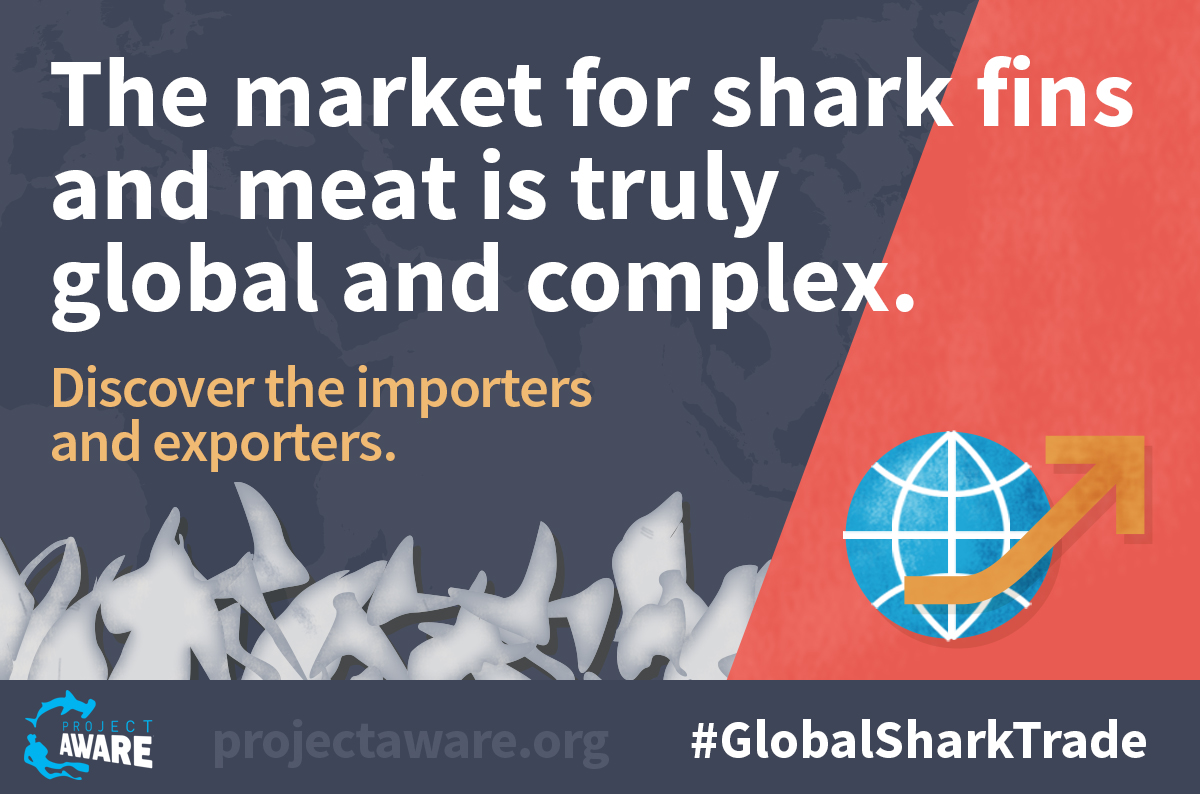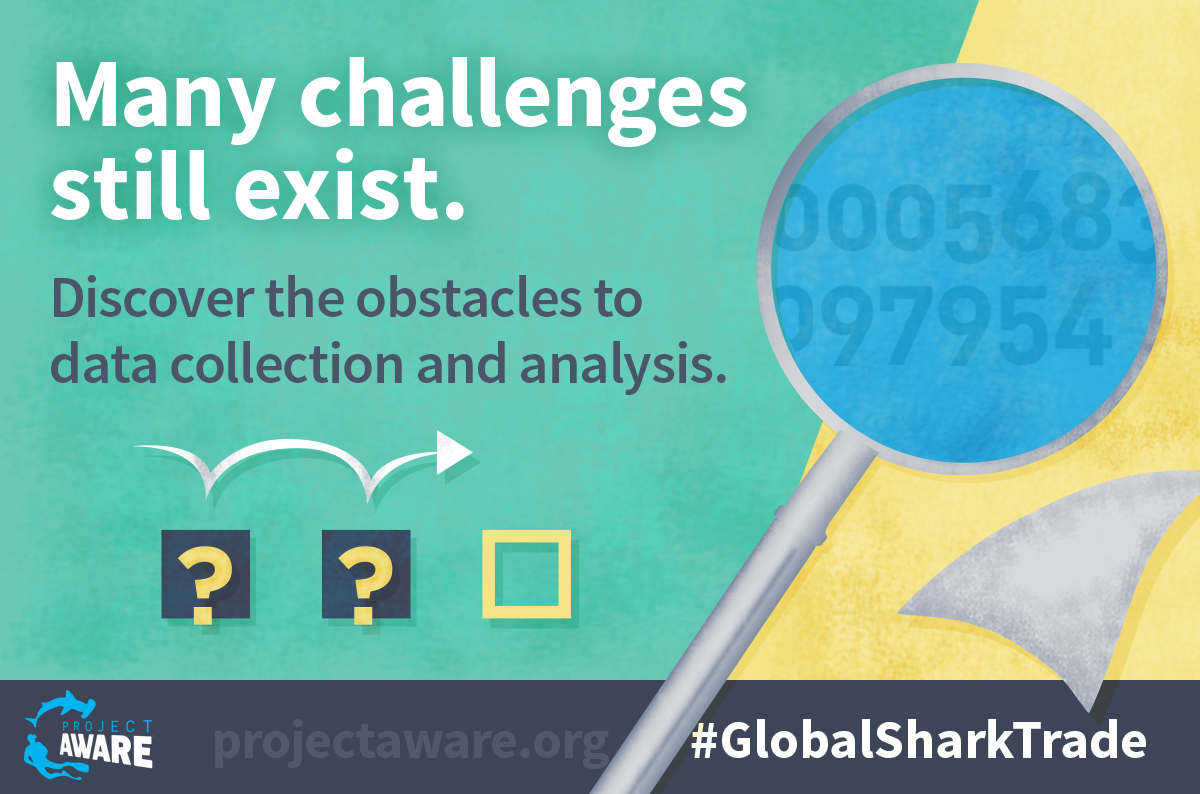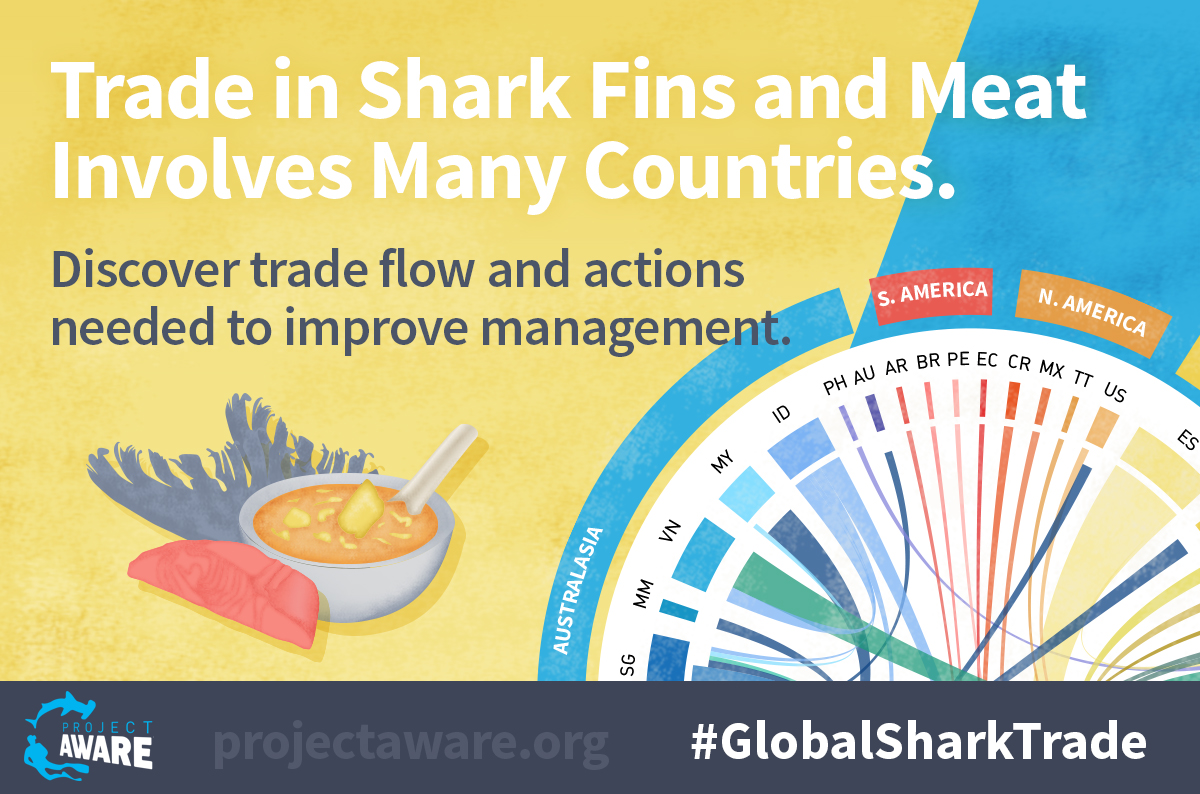New Infographic Busts Myths about Global Shark Trade
Think it’s all about fins and China? Think again
 A new interactive infographic, from the environmental organization Project AWARE®, illustrates the full story of current, trade-related threats to shark and ray populations based on the United Nations Food and Agriculture Organization (FAO) 2015 report “State of the Global Market for Shark Products” by Felix Dent and Shelley Clarke.
A new interactive infographic, from the environmental organization Project AWARE®, illustrates the full story of current, trade-related threats to shark and ray populations based on the United Nations Food and Agriculture Organization (FAO) 2015 report “State of the Global Market for Shark Products” by Felix Dent and Shelley Clarke.
 The appetite for shark fin soup has played a major role in shark overfishing and is often positioned as the main threat to sharks today. Recent data on international trade in shark fins and meat analyzed in the report however, reveals a global, interdependent market for a variety of shark products across scores of countries, including several in South America and Europe, whose demand for shark meat places them among the world's top shark consumers.
The appetite for shark fin soup has played a major role in shark overfishing and is often positioned as the main threat to sharks today. Recent data on international trade in shark fins and meat analyzed in the report however, reveals a global, interdependent market for a variety of shark products across scores of countries, including several in South America and Europe, whose demand for shark meat places them among the world's top shark consumers.
 "With so many shark species and products in trade, it can be difficult to get your head around what is really happening,” says Dr. Shelley Clarke, co-author of the FAO shark trade report and renowned shark fisheries scientist. “Understanding sources and trends is a critical step toward making sure the trade is sustainable and traceable, and the underlying fisheries are properly managed.”
"With so many shark species and products in trade, it can be difficult to get your head around what is really happening,” says Dr. Shelley Clarke, co-author of the FAO shark trade report and renowned shark fisheries scientist. “Understanding sources and trends is a critical step toward making sure the trade is sustainable and traceable, and the underlying fisheries are properly managed.”
With technical assistance from Dr. Clarke, as well as Sonja Fordham, a shark and ray policy expert, Project AWARE created a visual representation of the report that debunks myths about the global shark trade and points the way to key improvements.
“We set out to make the findings of the landmark 2015 FAO shark product report more accessible and actionable,” said Domino Albert, Project AWARE’s Associate Director for Global Communications. “In addition to mapping out the top shark trading countries and routes, the infographic offers a close look at the challenges researchers face when studying these global markets, and highlights the measures necessary to increase trade traceability and sustainability.”
 The infographic reveals the significant growth in markets for shark and ray meat, as well as the countries and inadequately restricted fisheries associated with this largely under-the-radar trade.
The infographic reveals the significant growth in markets for shark and ray meat, as well as the countries and inadequately restricted fisheries associated with this largely under-the-radar trade.
“The shark fin trade is at long last receiving worldwide attention from the media, conservationists, and law-makers, but we must urgently broaden our horizons to also consider other threats to sharks and closely related rays,” said Sonja Fordham, President of Shark Advocates International, a project of The Ocean Foundation. “We hope that Project AWARE’s initiative will shine light on these emerging issues and channel public concern toward workable solutions before it’s too late.”
The interactive infographic and related information can be found here: www.projectaware.org/globalsharktrade
Follow the online conversation with the hashtag #GlobalSharkTrade
Key facts about the Global Shark Trade:
- Hammerhead, oceanic whitetip and blue sharks are preferred for shark fin soup whereas dogfish, mako and tope sharks are preferred for meat
- From the country of production to the country where the products are consumed, shark products are often imported and exported much more than three times
- The vast majority of shark fins are destined for consumption in a relatively small selection of countries and territories in East and Southeast Asia. The world’s largest consumers of shark meat are found in South America and Europe
- Markets for shark meat are much more diverse and geographically dispersed than those for shark fins. European and North American markets such as the USA, Italy and France show a preference for dogfish species
- Between 2000 and 2011, the annual volume for shark fin imports has decreased by 5% while the annual volume for shark meat imports has increased by 42%
- Shark meat markets have expanded considerably due to a combination of demand growth and finning bans intended to encourage the full utilization of carcasses
- The world’s major shark fin exporting producers are Spain, Indonesia, Taiwan, and Japan
- Hong Kong is not a producer, and essentially the entirety of its outgoing trade consists of shark fins that have been imported from shark-catching countries or regional traders and then re-exported
- Sometimes shark fins are reported as shark meat making the reporting imprecise and not reliable
- Separate World Customs Organization commodity codes should be implemented for shark fins and shark meat as a matter of urgency in order to continue meaningful trade monitoring
Photo courtesy of Dominic Ziegler



